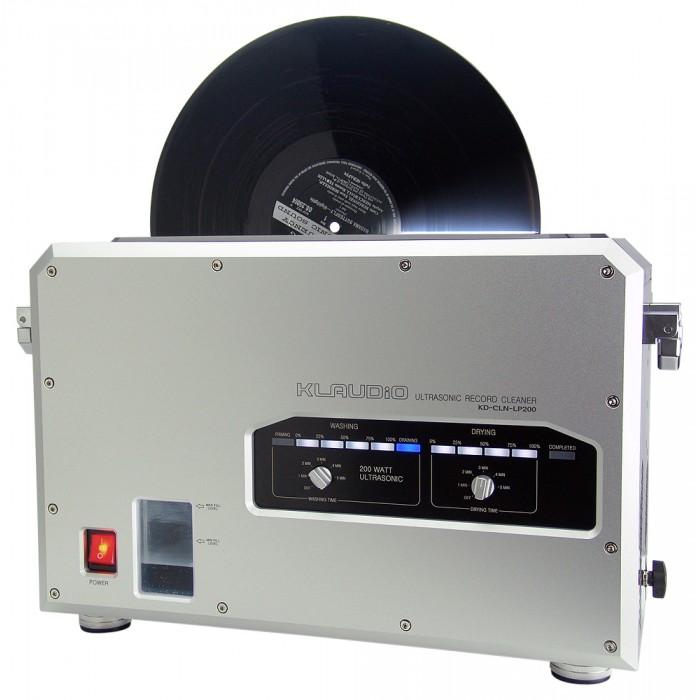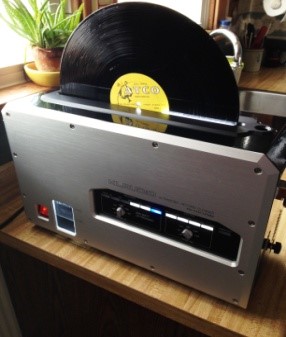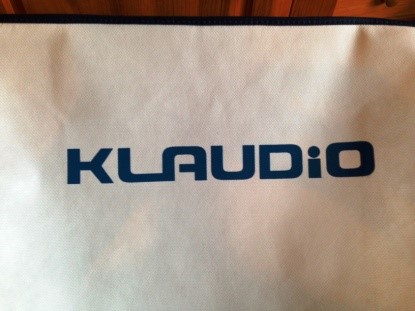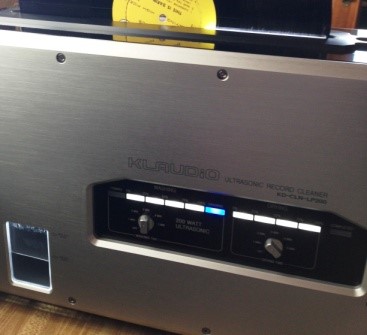Give Your Vinyl Albums a Fresh Clean Start
FTC Statement: Reviewers are frequently provided by the publisher/production company with a copy of the material being reviewed.The opinions published are solely those of the respective reviewers and may not reflect the opinions of CriticalBlast.com or its management.
As an Amazon Associate, we earn from qualifying purchases. (This is a legal requirement, as apparently some sites advertise for Amazon for free. Yes, that's sarcasm.)

For a vinylphile like me theses are marvelous times.
Records are making/have made a comeback. Whether it is because people have finally come to their senses that vinyl records sound superior to any other recorded medium, or because records companies are trying to find a way to make money again now that the people who forsook records for ease and portability have now forsaken that medium for the even worse sound but greater portability of digital file music, and they need something to generate cash flow for them now, they’ve realized that the record faithful have never gone away. We’ve just stood in the shadows, intent on letting the trends go by while we bask in sonic superiority listing to great music spinning on our turntables.
Whatever the real reason the record companies have decided to make LP’s again is really irrelevant. The fact is they are back in the groove again, and I am happy.
What I’m not so happy about is the rather pricey sums they are asking for these new records, just like the exorbitant prices they asked for the first CD’s when they came out. These expensive new pressings are bringing people to the used record stores in droves to pick up original pressing of records which, while driving those prices up somewhat, are still a lot less expensive in most cases -- and in some cases superior sounding.
This brings me to the crux of my review.
With new records costing so much and used records being, well, used, it is very important to clean and keep clean these records to keep them sounding their best for years to come.
LP playback systems are better now than they ever have been; good quality turntables, tone arms and cartridges are more abundant now then they have ever been, and more affordable too. While, yes, it is true that some LP playback systems can cost more than homes these days, a very large number are affordable and more than capable of extracting the wonderful music hiding within the grooves of the records. All the more reason to keep our records clean.
And by clean I don’t mean the old fashioned dish liquid and old sock method of yesteryear, or just a mere record brush. I mean clean clean. Clean that can only be done by a record cleaning machine.
We are also fortunate these days to have quite a few very good record cleaning devices available to us from various companies. I’d venture to say that for a good portion of audiophiles like myself that would come most likely in the form of a cleaner from Nitty Gritty or, in my case, from a VPI model 16.5, the workhorse of vinyl cleaners found in most audiophile’s homes.
And while the VPI does a wonderful job, it is not the subject of my review.
This review is for the KLAudio Ultrasonic Record Cleaner KD-CLN-LP200 (hither to in this reviewed referred to as simply the LP200)
 The LP200 retails for $3,999.99 -- no small chunk of change, and a good deal more than my VPI which I have already said does a very good job.
The LP200 retails for $3,999.99 -- no small chunk of change, and a good deal more than my VPI which I have already said does a very good job.
Why then, you may ask, would I be looking at another more expensive cleaner if the VPI does a very good job now for me?
Well, that is easy. You see, before I heard (key word heard) the difference in the way an LP sounded after using the LP200, I had already cleaned it with my VPI and listened to it and I thought it did a great job. An audibly better job couldn’t be had. But, after I then cleaned it with the LP200, I discovered very quickly that indeed a better job could be done -- a job so much better, in fact, that the difference was easily and quite clearly audible.
I didn’t have to try and listen hyper-critically to try and pick up subtle nuances to deem it in some way better. No. This was “in my face” apparent very shortly after putting the needle on the groove and the music starting.
So what is the LP200 Ultrasonic Record Cleaner? Yes, I said ultrasonic -- no brushes here.
Well, when I first saw it at Charlie Schnyder’s Stereo Haven in Edwardsville IL, I first thought it a dead-ringer for a toaster, as its shape and cover reminded me of one I had in the past. (Didn’t hurt the mental image either that it also resided in the kitchen area.)
 That slight similarity aside, the LP200 is a beautiful, extremely well built piece of audio equipment. Just looking at it, it is immediately apparent that this is solid and built like a tank. But it is also very clean and ergonomic in appearance and operation.
That slight similarity aside, the LP200 is a beautiful, extremely well built piece of audio equipment. Just looking at it, it is immediately apparent that this is solid and built like a tank. But it is also very clean and ergonomic in appearance and operation.
The unit cleans records in two adjustable cycles: 1 cycle for wash and 1 for dry. The entire wash and dry process can be adjusted from 2 to 10 minutes. I like flexibility like this as some records may not need as much cleaning as others.
The LP200, unlike my VPI, does not use any special cleaner or have brushes or wands that wear out. The LP200 uses distilled water -- just regular old fashioned distilled water available at, well, everywhere for like $1 a gallon! And it’s not like you keep filling it after every use. As you watch it clean, it takes water from its reservoir and when it’s done cleaning, while it starts the dry cycle, the water is returned to the reservoir. You just need to change it when it gets too dirty. Changing is easily done by connecting a hose to the unobtrusive spigot on the rear and draining it into a sink, bowl or other container. And did I mention: there are no parts that need replacing!
To use (after turning it on) you choose how long you want the cycles to run, place the record in the slot opening at the top (like you would a piece of toast), hit Start, and you hear the water go somewhere and the record starts spinning. If you turn you head just so, you can just peer into the slot somewhat and see the water run over the LP, and you hear what I can only imaging are the sonic “waves” doing whatever it is they do to or with the water to clean the record. It’s a little like hearing electricity but not quite.
I’m in no way an engineer and will not pretend I know or understand exactly what it’s doing, but then I don’t have to as long as it does.
While it is working it is not that loud, although the drying cycle is louder than the cleaning cycle. Still, it is nowhere near as load as my VPI. Lights on the side indicate the progress of the cleaning and drying as the cycles go along (25%, 50%. 75%, 100%) and If the sound bothers you, you can put it in another room and let it clean the record in there; the unit stops on its own when it is done!
To audition what kind of a job this ultrasonic cleaner that uses water would do as compared to the special cleaner/brush/vacuum job my VPI does, I brought over with me LPs that I had found while mining used record shops: LP treasures of wonderful music that, unfortunately, their previous owner(s) didn’t treat with the respect they deserved. My VPI did a very good job of cleaning them, but there was still audible noise that I figured was just always going to be there. I had been using them in heavy rotation, so I was comfortable with how they sounded.
We listened to the LPs first to get acquainted with the way they sounded on the equipment we were listening to them on: a system consisting of Line Magnetic tube amplification, Well Tempered Labs, EMT table/cartridge combination, Auditorium Cables and DeVore O/96 Speakers. We listened to them one at a time, and once I felt familiar with how a record sounded on this very detailed, articulate, high resolution system, we ran it thru the LP200 and put it back on the table. Sound levels and everything else remained exactly the same.
A couple of the Jazz records I brought were recorded in the early 60’s, and included string sections in their accompaniments. While the bass and midranges, and most of the high frequencies, were recorded very well, these albums had the all too typical “screaming strings” (as Charlie so accurately referred to them) sound so common to music recorded those days.
On first listening before using the LP200, they sounded just as they did on my home system: screaming, and the bass, though deep, was not overly well defined and had a boominess sound that instead of a note just ending they seem to “vibrate” onward.
Now there are many things that could have affected this sound, but the reality is, it sounded the way it did, and after cleaning, apart from being visibly newer looking, it was immediately audibly noticeable that those screaming strings were much less screaming -- more refined and under control, still bright, but less so, and the bass was now more defined as well, less boomy.
Imaging too was brought more into focus, and I hadn’t expected that.
Now don’t get me wrong; this machine is not a miracle worker. A scratch or nick is a scratch or nick, and nothing is going to repair that kind of damage. But the records were noticeably better sounding, apart from what I mentioned above; the spaces between the instruments were blacker, quieter; there was more air as well.
Now it’s not that this cleaner altered the records in any way, or added anything to them. It just cleaned them and allowed what was there to be picked up and played by the system -- played the way they were originally intended and, perhaps, hadn’t sounded like since they were new. If one really thinks about it, there is a huge amount of information very minutely recorded in between those grooves, minute information that conveys things like space, tone, and texture, all being picked up by a needle gently riding between the walls of those grooves. How small does something have to be to muddy all that up? I can imagine it only has to be minute and that there could have been some smaller than the eye can see particles that were lodged in there stopping the needle from picking up all of the notes, all of the information. The LP200 got it out of there in a way that cleaning solution and brushes with vacuums just couldn’t get. And it did this on each record we played, cleaned, and played again; records that I’ll remind you again were cleaned by my cleaning machine before coming there. They each sounded markedly better. Even some that were I thought in pristine clean condition had a more open, focused sound to them. Truly remarkable!
Now again talking about price: $4K is not something that I or many have just lying around their home, but you know, I for one can personally say, this unit is worth every penny and I am going to start saving for one. I don’t know why people have this aversion these days of saving up for something they want. The LP200 is something that I feel very strongly will help keep my albums sounding their best forever, and as I find other used musical treasures (there is so much wonderful music out there waiting to be rediscovered that we never knew was recorded) I will be able to give them a truly excellent cleaning and be able to get the most out of them. Shoot, I can’t wait to get it just to re-clean all of my albums that I currently have.
If you are fortunate enough to be able to afford the LP200 now, and vinyl playback is as important to you as it is to me, I don’t see how you could not get one of these right away to hear what you’ve been missing. For more information on the LP200, contact Charlie at Stereo Haven at charlie@sterohaven.com.


